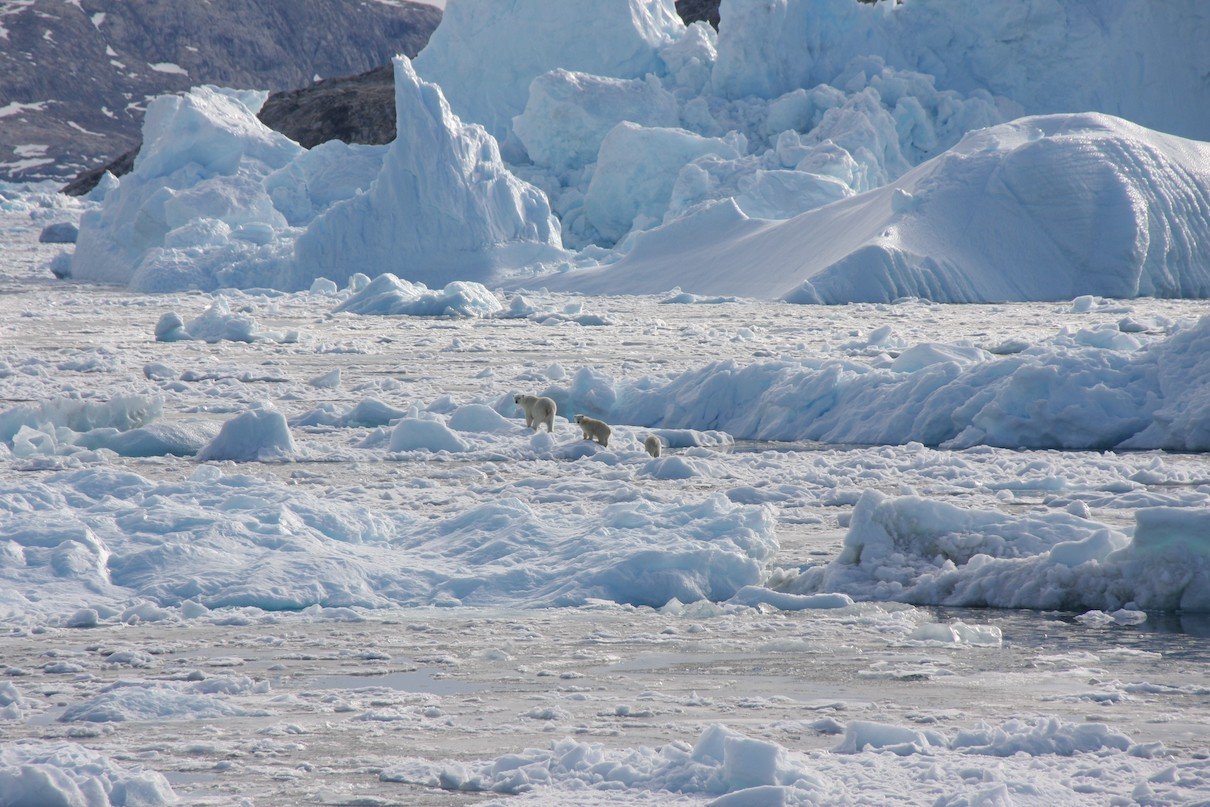- Scientists recently discovered a new subpopulation of polar bears living in southeast Greenland that is genetically and behaviorally distinct.
- While most polar bears depend upon sea ice for survival, the polar bears in Southeast Greenland use pieces of glacial ice as habitat and hunting platforms.
- Large numbers of polar bears are expected to decline as climate change accelerates, but small populations may persist in places like this, where the pace of melting is expected to be slower, experts say.
When Kristin Laidre began working on a long-term project to study polar bears in eastern Greenland, she didn’t expect to find a new subpopulation of the species — and she certainly didn’t expect to find the most genetically isolated polar bears on the planet.
There are 19 recognized subpopulations of polar bears (Ursus maritimus) living throughout the Arctic, including the subpopulation found living on the eastern coast of Greenland. But on the southeastern edge of the island, Laidre and her colleagues found a group of several hundred polar bears that were both behaviorally and genetically unique. While most polar bears depend on sea ice to hunt seals, the southeast Greenland polar bears had found ways to hunt using pieces of ice that had broken off from glaciers.
“We were not expecting to identify a unique group like we found in the southeast,” Laidre, a polar bear expert at the University of Washington and Greenland Institute of Natural Resources, told Mongabay in an email.
A new report published in Science by Laidre and her colleagues suggests that the glacial ice, known as “marine-terminating glaciers,” could serve as “previously unrecognized climate refugia,” showing how polar bears might be able to survive in a warming world.
In the southeast part of Greenland, sea ice is relatively scarce, materializing for less than 100 days per year. Comparatively, a polar bear’s seasonal fasting period usually lasts between 100 and 180 days, the study says. In lieu of sea ice, these polar bears were using glacial ice as habitat and hunting platforms.
Twila Moon, a climate scientist at the University of Colorado and co-author of the report, said that this discovery was “surprising and exciting.”
“As a glaciologist, I had not previously thought of glacial ice as important habitat for polar bears,” she told Mongabay in an email.
Marine-terminating glaciers can be found in pockets around the Arctic, but Greenland glaciers produce a particularly large amount of glacial ice “since they are fed by the large reservoir of ice contained in Greenland,” Moon said. Even in a trajectory of continued warming and ice loss, the glaciers in the southeast section of Greenland are not expected to retreat as quickly as the ice in other parts of the country, she added.
Polar bears are considered to be vulnerable to extinction, largely due to the rapid decline of sea ice brought on by climate change. One study has suggested that most polar bears could disappear by 2100 if the world continues to rapidly warm.

Another study found that Greenland’s ice is melting faster than it has at any point in the past 12,000 years, which could contribute to a sea level rise of up to 10 centimeters (4 inches) across the globe by the end of this century.
Laidre said genetic diversity is important for polar bear conservation. However, she added that the newly identified subpopulation of polar bears could help us understand how polar bears might be able to survive in the future.
“There are limited locations in the Arctic where this type of glacial ice environment is available, so we still expect to see large declines in polar bears across the Arctic as sea ice continues to diminish under climate change,” she said. “[But] with future study, these bears may show us where small numbers of bears can persist in an ice-free Arctic.”
Citation:
Molnár, P. K., Bitz, C. M., Holland, M. M., Kay, J. E., Penk, S. R., & Amstrup, S. C. (2020). Fasting season length sets temporal limits for global polar bear persistence. Nature Climate Change, 10(8), 732-738. doi:10.1038/s41558-020-0818-9
Briner, J. P., Cuzzone, J. K., Badgeley, J. A., Young, N. E., Steig, E. J., Morlighem, M., … Nowicki, S. (2020). Rate of mass loss from the Greenland Ice Sheet will exceed Holocene values this century. Nature, 586(7827), 70-74. doi:10.1038/s41586-020-2742-6
Laidre, K. L., Supple, M. A., Born, E. W., Regehr, E. V., Wiig, O., Ugarte, F., … Shapiro, B. (2022). Glacial ice supports a distinct and undocumented polar bear subpopulation persisting in late 21st-century sea-ice conditions. Science, 376(6599). doi:10.1126/science.abk2793
Banner image caption: Polar bears in Manitoba, Canada. Image by Brocken Inaglory / Wikimedia Commons.
Elizabeth Claire Alberts is a staff writer for Mongabay. Follow her on Twitter @ECAlberts.
FEEDBACK: Use this form to send a message to the author of this post. If you want to post a public comment, you can do that at the bottom of the page.














